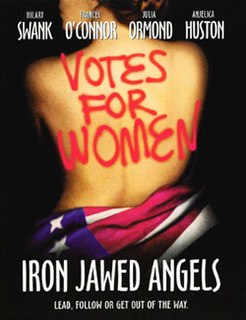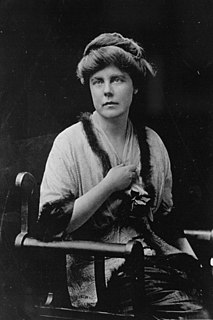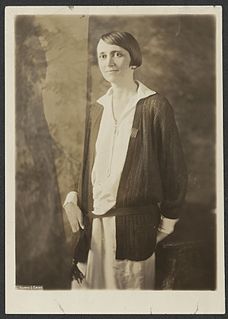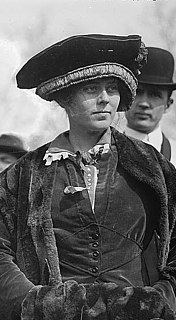
The Nineteenth Amendment to the United States Constitution prohibits the states and the federal government from denying the right to vote to citizens of the United States on the basis of sex. Initially introduced to Congress in 1878, several attempts to pass a women's suffrage amendment failed until passing the House of Representatives on May 21, 1919, followed by the Senate on June 4, 1919. It was then submitted to the states for ratification. On August 18, 1920, Tennessee was the last of the necessary 36 states to secure ratification. The Nineteenth Amendment was officially adopted on August 26, 1920: the culmination of a decades-long movement for women's suffrage at both state and national levels.

The National American Woman Suffrage Association (NAWSA) was an organization formed on February 18, 1890, to advocate in favor of women's suffrage in the United States. It was created by the merger of two existing organizations, the National Woman Suffrage Association (NWSA) and the American Woman Suffrage Association (AWSA). Its membership, which was about seven thousand at the time it was formed, eventually increased to two million, making it the largest voluntary organization in the nation. It played a pivotal role in the passing of the Nineteenth Amendment to the United States Constitution, which in 1920 guaranteed women's right to vote.

Alice Stokes Paul was an American suffragist, feminist, and women's rights activist, and one of the main leaders and strategists of the campaign for the Nineteenth Amendment to the U.S. Constitution, which prohibits sex discrimination in the right to vote. Paul initiated, and along with Lucy Burns and others, strategized events such as the Woman Suffrage Procession and the Silent Sentinels, which were part of the successful campaign that resulted in the amendment's passage in 1920.

Iron Jawed Angels is a 2004 American historical drama film directed by Katja von Garnier. The film stars Hilary Swank as suffragist leader Alice Paul, Frances O'Connor as activist Lucy Burns, Julia Ormond as Inez Milholland, and Anjelica Huston as Carrie Chapman Catt. It received critical acclaim after the film premiered at the 2004 Sundance Film Festival.

The National Woman's Party (NWP) is an American women's political organization formed in 1916 to fight for women's suffrage. After achieving this goal with the 1920 adoption of the Nineteenth Amendment to the United States Constitution, the NWP advocated for other issues including the Equal Rights Amendment. The most prominent leader of the National Woman's Party was Alice Paul, and its most notable event was the 1917–1919 Silent Sentinels vigil outside the gates of the White House.

Lucy Burns was an American suffragist and women's rights advocate. She was a passionate activist in the United States and in the United Kingdom. Burns was a close friend of Alice Paul, and together they ultimately formed the National Woman's Party.

The Silent Sentinels were a group of women in favor of women's suffrage organized by Alice Paul and the National Woman's Party. They protested in front of the White House during Woodrow Wilson's presidency starting on January 10, 1917. The Silent Sentinels started to protest after a meeting with the president on January 9, 1917, during which he told the women to "concert public opinion on behalf of women's suffrage." The protesters served as a constant reminder to Wilson of his lack of support for suffrage. At first the picketers were tolerated, but they were later arrested on charges of obstructing traffic. The women protested at the White House gates and later in Lafayette Square until June 4, 1919 when the Nineteenth Amendment to the United States Constitution was passed both by the House of Representatives and the Senate.

Women's suffrage in the United States of America, the legal right of women to vote, was established over the course of more than half a century, first in various states and localities, sometimes on a limited basis, and then nationally in 1920.

The Congressional Union for Woman Suffrage was an American organization formed in 1913 led by Alice Paul and Lucy Burns to campaign for a constitutional amendment guaranteeing women's suffrage. It was inspired by the United Kingdom's suffragette movement, which Paul and Burns had taken part in. Their continuous campaigning drew attention from congressmen, and in 1914 they were successful in forcing the amendment onto the floor for the first time in decades.

The Alpha Suffrage Club was the first and most important black female suffrage club in Chicago and one of the most important in Illinois. It was founded on January 30, 1913 by Ida B. Wells with the help of her white colleagues Belle Squire and Virginia Brooks. The Club aimed to give a voice to African American women who had been excluded from national suffrage organizations such as the National American Women Suffrage Association (NAWSA). Its stated purpose was to inform black women of their civic responsibility and to organize them to help elect candidates who would best serve the interests of African Americans in Chicago.

Laura Clay, co-founder and first president of the Kentucky Equal Rights Association, was a leader of the American women's suffrage movement. She was one of the most important suffragists in the South, favoring the states' rights approach to suffrage. A powerful orator, she was active in the Democratic Party and had important leadership roles in local, state and national politics. In 1920 at the Democratic National Convention, she was one of two women, alongside Cora Wilson Stewart, to be the first women to have their names placed into nomination for the presidency at the convention of a major political party.

Florence Brooks Whitehouse was an American suffragist, activist and novelist from Maine. In 2008, Whitehouse was inducted to the Maine Women's Hall of Fame. She was an early feminist who was considered radical for her support of Alice Paul and the tactics of the National Women's Party.

Mabel Vernon was an American suffragist, pacifist, and a national leader in the United States suffrage movement. She was a Quaker and a member of the American Woman Suffrage Association. Vernon was inspired by the methods used by the Women's Social and Political Union in Britain. Vernon was one of the principal members of the Congressional Union for Women Suffrage (CUWS) alongside Olympia Brown, Inez Milholland, Crystal Eastman, Lucy Burns, and Alice Paul, and helped to organize the Silent Sentinels protests that involved daily picketing of Woodrow Wilson's White House.

Nina Evans Allender was an American artist, cartoonist, and women's rights activist. She studied art in the United States and Europe with William Merritt Chase and Robert Henri. Allender worked as an organizer, speaker, and campaigner for women's suffrage and was the "official cartoonist" for the National Woman's Party's publications, creating what became known as the "Allender Girl."

Sue Shelton White, called Miss Sue, was a feminist leader originally from Henderson, Tennessee, who served as a national leader of the women's suffrage movement, member of the Silent Sentinels, editor of The Suffragist.

May Jane Walker Burleson - "Jennie" May Burleson (1888-1957) was a notable socialite, artist, and Texan suffragette who was the Grand Marshal of the Woman Suffrage Parade of 1913 in Washington, DC. Mounted with confidence on her horse, she led a parade of 5,000 people up Pennsylvania Avenue, Washington, DC and "into a melee that changed the direction of the suffrage movement." During the 1930s her name was associated with scandal, attracting wide media attention in Texas, as she shot and killed the woman her husband married after their contentious divorce in 1938.
This timeline highlights milestones in women's suffrage in the United States, particularly the right of women to vote in elections at federal and state levels.

Elsie Hill was an American suffragist, as were her sisters Clara and Helena Hill.
Women's suffrage in states of the United States refers to women's right to vote in individual states of that country. Suffrage was established on a full or partial basis by various towns, counties, states and territories during the latter decades of the 19th century and early part of the 20th century. As women received the right to vote in some places, they began running for public office and gaining positions as school board members, county clerks, state legislators, judges, and, in the case of Jeannette Rankin, as a Member of Congress.

Caroline Katzenstein was an American suffragist, activist, advocate for equal rights, insurance agent, and author. She was active in the local Philadelphia suffragist movement through the Pennsylvania branch of the National American Woman Suffrage Association and the Equal Franchise Society of Philadelphia. She played a role in the formation of the Congressional Union for Women Suffrage, which later became the National Women's Party. Katzenstein was also active in the movement for equal rights, serving on the Women's Joint Legislative Committee with Alice Paul, and championing the cause for the Equal Rights Amendment. She was the author of Lifting the Curtain: the State and National Woman Suffrage Campaigns in Pennsylvania as I Saw Them (1955).





























